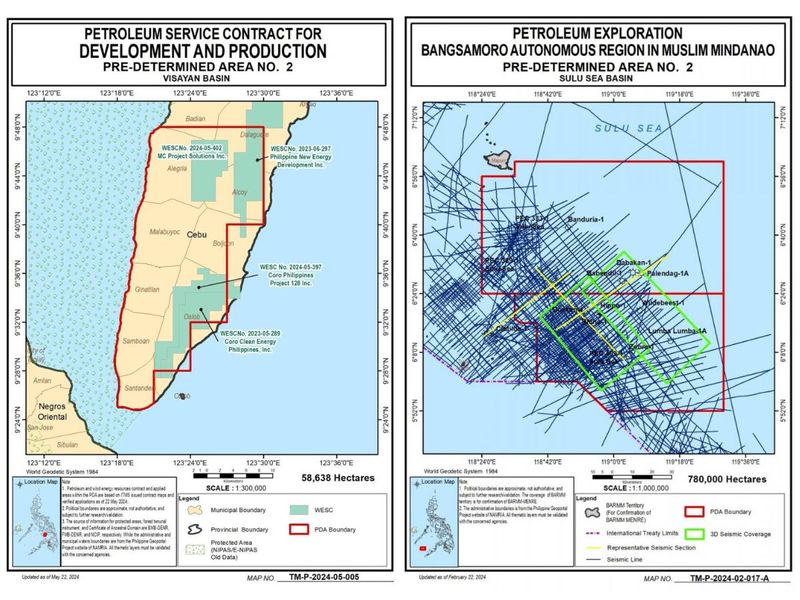
Highlights
- 50 companies have shown interest in exploring new possible oil, gas and coal deposits.
- For decades, security concerns and limited investments have hampered oil and gas exploration efforts in the Asian country.
- One estimate states that only about 10 per cent of the country's territory has viable geological data that can be useful for oil and gas exploration.
- The country is pushing a multi-pronged strategy to sustain the peace and bolster investments to unlock the investment potential for its energy sector.
Manila: Oil and gas exploration in the Philippines is getting re-ignited. To this list, add coal too. This renewed interest in fossil fuels could usher in fresh multi-million investments, which could bolster the country's energy security.
Several projects are underway, spearheaded by the Department of Energy (DoE), which is also heavily promoting renewables.
The most prominent fossil-fuel prospecting currently involves an unprecedented deep sea exploration as part of the Malampaya Phase 4 (MP4) gas field project. Malampaya is the country's first and only indigenous liquid natural gas (LNG) resource at the moment.
Operated by Prime Energy Resources Development B.V. (Prime Energy), the Malampaya gas-to-power project is located off the coast of Palawan.
The field has already served the country for more than 20 years, and currently powers 20 per cent of the power grid in Luzon, an island more than thrice the size of Belgium.
Ilijan Combined-Cycle Power Plant, a dual-fuel power station in Batangas (south of Manila), is primarily a natural gas plant which also uses distillate oil as a secondary back-up fuel source. With a capacity of 1200 MW, it is the largest natural gas facility in the Philippines.
1,200 MW
production capacity of Ilijan Combined-Cycle Power Plant in Batangas, which uses natural gas as primary fuel and distillate oil as a secondary back-up fuel source.Currently, a relatively small amount of oil is produced in the country, mainly sourced from Galoc, Nido, Matinloc, and North Matinloc — all offshore fields. Malampaya offshore and Alegria onshore fields produce gas and condensate (oil).
Malampaya produces about 429 million cubic feet per day (12.1 million m3 per day) of gas at standard conditions, and about 15,000 barrels (2,400 m3) per day condensate (oil).
Alegria, an onshore site with an estimated 3.35 million barrels of recoverable oil (out of a reserve of 27.93 million barrels) is also a natural gas field hosting an estimated 9.42 billion cubic feet of natural gas, with reserves estimated to last until 2037.
Fresh drilling projects
Now, new areas for prospectors had been opened, in addition to Malampaya ang Alegria.
And while existing Malampaya offshore wells are expected to be depleted by 2027, Phase 4 could give this area under Service Contract No. 38 (SC38) a new lease on life.
SC38, renewed in April 2023, is expected to see a multi-million-dollar exploration work.

In February, Prime Energy announced the award of a contract to One Subsea (under Schlumberger group) for the supply of wellheads, “Christmas Trees”, and subsea production system by end-2024 for MP4.
These will be used to drill and tie-in two new deepwater wells in the Camago and Malampaya East fields to the Malampaya Shallow Water Platform.
Located in offshore Northwest Palawan in the West Philippine Sea, the Nido field was discovered in 1977, followed by the Matinloc blocked field in 1979.
The fields produced a total volume of around 31.9 million barrels of oil until the end of their field life in 2019.
Drilling from 2025
Drilling is planned for 2025. And if things go well, new gas could be delivered by 2026.
The pace of development has accelerated: In March (2024), Prime Energy awarded a $69.9-million contract for MP4 to Noble, a Texas-based offshore drilling company.
The deal covers the use of Noble’s deepwater drillship “Noble Viking”, which will be put to work on the Camago and Malampaya East fields – as well as a third exploration well, dubbed “Bagong Pagasa”, approximately 15 kilometers north of Malampaya.
Areas of interest: Cagayan, Ragay Gulf, Mindoro, Palawan, Cebu, Cotabato
Other onshore and offshore areas like Cagayan, Ragay Gulf, Mindoro, Palawan, Cebu, and the Cotabato Basin are believed to hold additional fossil fuel resources.

Discoveries like the on-shore Alegria field in Cebu (27.93 million barrels of oil) and the Liguasan Marsh (estimated 3.4 TCF of natural gas) highlight the potential.
50 companies interested
In terms of petroleum exploration, the Philippines remains largely "under-explored": only about 10 per cent of the country's territory has viable data, according to GeoExpro, an energy industry publication.
This is due in part to the decades-old peace and order situation and internal security challenges posed by the communist insurgency and separatism in the country's south.

While challenger remain, energy demand is expected to continue on its growth path: The real GDP of the Philippines is estimated to be $422 billion at the end of 2023.
Having grown faster than other economies in Southeast Asia in 2023, ending the year with a 5.6 percent growth rate, the Philippines can expect a similarly healthy growth outlook for 2024, according to an analysis by McKinsey in partnership with Oxford Economics.
DOE's “Natural Gas Development Plan” released in 2022 projects that the country needs an additional 25,265 MW of “baseload” power capacity between now and the year 2040.
The DOE considers natural gas as baseload (accounting for more than 50 per cent of projected additional capacity by 2040) — hydro is considered as baseload only in rainy season, while wind and solar are subject to availability.
DOE has ignited the race for a fresh round of prospecting. Earlier this year, the agency launched a bidding process for the exploration of coal, petroleum, and native hydrogen across the country.
Over 50 companies showed intent in a potential energy bonanza, the agency reported.
8 areas for exploration
In the past, explorations in the southern parts of the country were hampered by security concerns. With the establishment of the Bangsamoro Autonomous Region in Muslim Mindanao (BARMM), and improved security, investor confidence has improved.
In February, the DOE launched eight predetermined areas (PDAs) on for the exploration, development, and production of indigenous energy sources across the country.

4 key BARMM areas
Four of these PDAs are in the Bangsamoro Autonomous Region in Muslim Mindanao (BARMM) – three were designated for petroleum and one for coal.
The coal exploration in BARMM, labeled PDA-BC-1, is located in Kapai and Tagoloan, Lanao del Sur, covering 14,856 hectares. Bidding for this project is exclusively open to local companies.
For petroleum exploration, the areas include PDA-BP-1 in the Cotabato Basin (Cotabato City and the provinces of Lanao del Sur and Maguindanao del Norte), covering a total area of 229,240 hectares. According to a DOE statement, 14 wells have been drilled in this area, with 10 showing oil and gas potential.
The other two petroleum exploration areas, PDA-BP-2 and PDA-BP-3, are located in the Sulu Sea Basin. PDA-BP-2, encompassing 780,000 hectares, has had six wells drilled, resulting in three gas discoveries and one oil and gas show. PDA-BP-3 covers 532,083 hectares, with seven wells drilled and four showing gas potential, according to the department.
4 areas in Luzon, Visayas
In addition to the 4 BARMM PDAs, four PDAs in Luzon and Visayas under the 2024 Philippine Bid Round 2 were offered to investors. Two of these are for petroleum development and production, while the other two are for the exploration of native hydrogen sources in the Zambales-Pangasinan area.

PDA-DP-1, located offshore Northern Palawan, covers a 100,000-hectare area 60 kilometers from the north coast of Busuanga Island.
It includes five wells, leading to the discovery of the Calauit and Calauit South oil fields, with an estimated reserve of 5.5 to 6.1 million barrels of oil (MMbbls). Recent studies revealed additional prospects ranging from 0.1 to 1.8 MMbbls of oil.
The Visayan Basin, or PDA-DP-2, in southern Cebu, covers 8,638 hectares with estimated resources of 26.3 to 31.9 MMbbls of oil and significant gas potential in other exploratory wells. Recent production from six wells in this block produced 19,791.26 barrels of crude oil from 2018 to 2023 in the municipality of Alegria.
The two PDAs for natural hydrogen exploration, PDA-PH-1 and PDA-PH-2, cover 134,096 and 96,439 hectares, respectively. The DOE stated that foreign entities could participate 100 percent in petroleum and natural hydrogen explorations in the country.
Exploring Ragay Gulf, Bondoc Peninsula
Research published in 2000 by Linda Sternbach of Star Creek Energy highlights the Ragay Gulf in the Philippines as a frontier basin with geological features similar to those found in Palawan and the Nido carbonate areas. This was backed by satellite magnetic mapping of the Gulf, which has identified a significant wrench fault.
The study also mentioned the Bondoc Peninsula in southeastern Luzon, noting numerous "surface oil seeps" around subsurface faulted highs and concentrations of hydrocarbons in surface water seepage collected in the area.
Modern marine seismic surveys, as well as 2D data from the 1980s and 1990s, have revealed several structures that could potentially serve as large-scale subsurface oil traps, including carbonate pinnacle reefs and carbonate banks.
Improved marine seismic data, showing better resolution of structural traps, have improved the focus on exploring carbonates in the area, a proven reservoir type found in other parts of the country.
The DOE said it will pick applicants with a "proven track record" in similar exploration and development projects.
Investor interest
Renewed exploration of the Philippines’ indigenous energy sources could be the next big thing. The country is also a make a big push for renewable energy.
"We're thrilled to see participation from established players across Asia, North America, and Europe," said DOE Undersecretary Alessandro O. Sales. "The Philippines offers attractive contractual terms that are competitive with other countries."
With a diverse range of resources up for grabs, the coming months will be crucial in determining who will play a role in the country's energy future.
The deadline for submission of bids for native hydrogen and petroleum PDAs is August 27, 2024. Notices of qualification for successful applicants are expected to be announced later this year.
By the numbers
- The Philippines consumes a significant amount of oil and gas (474,000 barrels per day) but produces only a fraction (37,000 barrels per day).
- A recent study estimates the Philippines holds untapped hydrocarbon resources worth a staggering $26.3 trillion, though largely still unproven.
- Besides Malampaya offshore field, other onshore and offshore areas like Cagayan, Ragay Gulf, Mindoro, Palawan, Cebu, and the Cotabato Basin are believed to hold additional resources.
- Discoveries like the Alegria field in Cebu (27.93 million barrels of oil) and the Liguasan Marsh (estimated 3.4 TCF of natural gas) highlight this potential.










